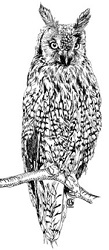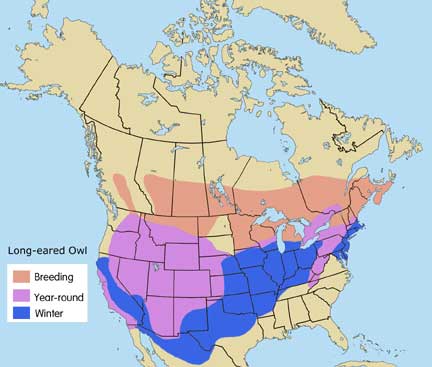
Scientific Name: Asio otus
A slender, medium-sized owl with long, narrow, rounded wings balanced by a long tail. The feathering of the upper body is a mottled [Courtesy of Barbara Gleason] dark brown, gray, and buff; the underside is whitish to tan with dark brown streaks and bars. Conspicuous “ear” tufts on a large, round head resemble the features of the Great Horned Owl, but the Long-eared Owl’s ear tufts are located higher on the head. Sexes have similar plumage, but females have a darker brown and deeper tan coloring. Yellow eyes with white “eyebrows” and a black bill underlined with white stand out in a facial disc of rusty tan feathers. This facial disc is a feature common to many owl species that rely on hearing to hunt, and helps direct sound to the ear. The bend of the wing shows a tan patch above, and a dark patch on the under wing which is visible in flight. This owl flies with flattened ear tufts, in a buoyant and irregular pattern. Camouflage is used for daytime protection by raising the ear tufts and stretching into a defensive posture, allowing the owl’s shape and feathering to blend into a background of tree limbs. As with most raptors, females are larger than males, and this species is smaller than its cousin the Short-eared Owl.
Male/Female
Length: avg. 15″
Wingspan: avg. 36″
Weight: avg. 9 oz.
State and federally protected.
This owl lives in edge environments: places where open country is found near wooded cover. Grasslands, shrub lands, meadows, or other open area habitats that are near patches of deciduous or coniferous forest will support this owl. They hunt in the open but need woodlands for roosting.
This bird is a nocturnal hunter that locates prey by sound. Small mammals form 95% of the diet in North America, but some birds, insects, amphibians, and reptiles may be taken as well. This owl hunts actively by flying low over open areas and woodland edges, and flying below the forest canopy in open forests. Most prey is captured on the ground, although birds roosting in low vegetation may also be caught.
Although silent most of the year, this species becomes more vocal during breeding season. Ooack, ooack, ooack barks of alarm may be heard at times, and adult males call attention to themselves with a widely spaced, long series of hoo…hoo…hoo…notes.
This owl takes over abandoned stick nests of other species, usually without adding any new material. Magpies, crows, hawks, ravens, and squirrels all construct tree-sited nests that attract Long-eared Owls. Their nesting preference is within a grove of trees where dense cover is provided, rather than in an isolated tree.
Sometimes collide with vehicles. A major problem for this owl is loss of riparian woodland, isolated tree groves, and open grassland habitat due to development, especially in the arid west.

In North America, the Long-eared Owl ranges throughout Canada and the northern US, across the western states, and extending south as far as central Mexico. This owl withdraws from the northern part of its range in winter.
Special Thanks for range maps:
Dan Gleason
BGleason Design & Illustration
Commercial & Scientific Illustration, Graphic Design
CraneDance Communications
Book Production/Design

